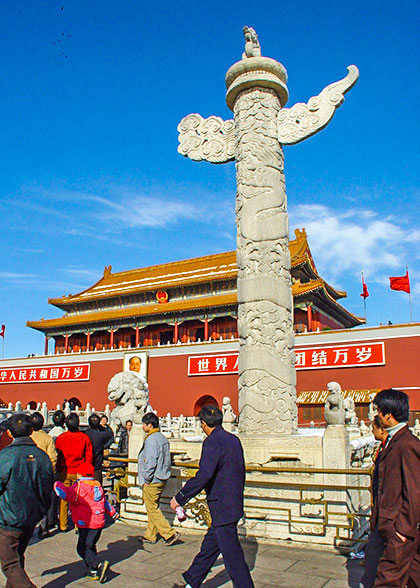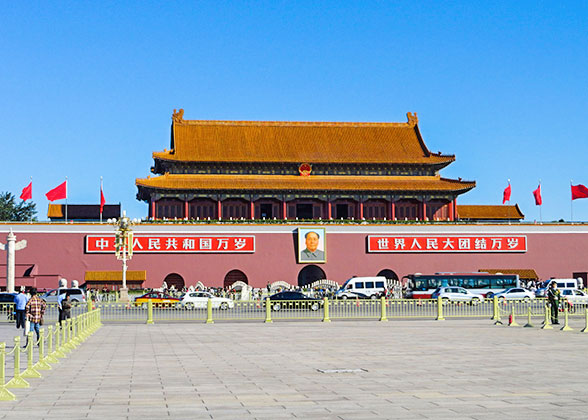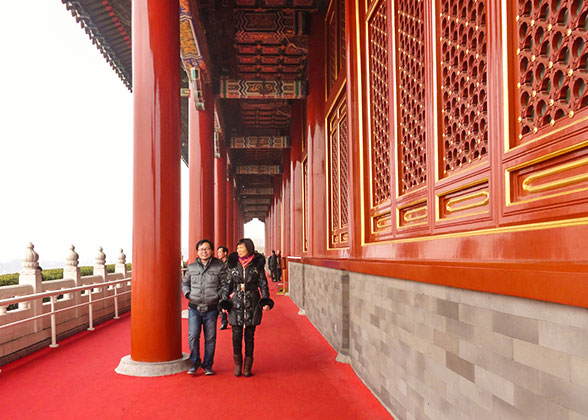Tiananmen Tower (Gate of Heavenly Peace)
Standing at the juncture where the central axis of Beijing and Chang'an Avenue meet, on the northern edge of Tiananmen Square, Tian'anmen Tower (Gate of Heavenly Peace) is the symbol of modern China and featured on the emblem of the People's Republic of China. It served as the gatehouse of the Ming and Qing Dynasties.
The building is 66 meters long, 37 meters wide and 32 meters high. It is made up of a platform and a tower. The tower sits on the platform with five arch gateways. As the largest of the five, the center archway is used as the specific passage for Ming and Qing emperors while the side ones are smaller and employed as the passages for ministers and officials.

Above the archway hangs a large portrait of Maozedong, on the east and west sides of which are two giant placards, the left one reading: "Long Live the People's Republic of China" while the right one reading: "Long Live the Great Unity of the World's Peoples." In front of the Tiananmen Tower is golden water bridge, above which spans 7 white marble bridges with fine carvings. Same as the arch gateways, the central bridge as the widest one was reserved for the emperor. In front of the central arch gateway are two a pair of stone columns, called huabiao, each weighs 10 ton and reaches about 10m. The two columns are carved with dragon design and have an animal "Wangtianhou" on top as decoration. Outside the gate there are two lions and two more guarding the bridges. Lions are believed to protect humans from evil spirits in Chinese culture. On the south of Tiananmen extends the No. 1 Street of Beijing, Chang'an Street, further south of which is the largest square in the world, Tiananmen Square. The tower sitting on the platform is a structure with double-eaved roof and yellow-glazed tiles. It is made 9 bays wide and 5 bays deep, which indicates the supremacy of the emperor.
|
|
On the two sides of the stone lions are reviewing stands. It was opened up to the public on the first day of 2012. Five thousand visitors were lucky to step up there and view the national flag rising that day. That was the first time the stands open up free to the public for since January 1, 1988. The reviewing stands now are available to group reservations for the opening day on the first day of each month. Only group reservations via local travel agencies are acceptable and should be submitted online before the 15th day of the previous month.
 |
| Marble Cloud Pillar |
How to get to Tiananmen Tower
1. Take bus 1, 5, 52, Sightseeing Bus Line 1, Sightseeing Bus Line 2, or Tourist Bus Line 2, and get off at Tiananmen Xi.
2. Take bus 1, 2, 52, 59, 82, 120, Sightseeing Bus Line 2 or Tourist Bus 2 to and Tiananmen Dong.
3. Take bus 120 or Sightseeing Bus Line 2 to Tiananmen Guangchang Xi (Tiananmen Square West).
By Subway:
1. Subway Line 1: get off at Tiananmen East or Tiananmen West Station.
2. Subway Line 2: get off at Qianmen Station and walk north.
Beijing Bus / Subway Search
| Entrance Fee | CNY 15 |
|---|---|
| Opening Hours | 8:30 - 17:00; ticket selling stops at 16:30. |
1. Tourists who go up to visit the tower are not allowed to take bags along. Bag Storage service is provided.
2. The renowned Forbidden City is reached through Tiananmen Gate.

